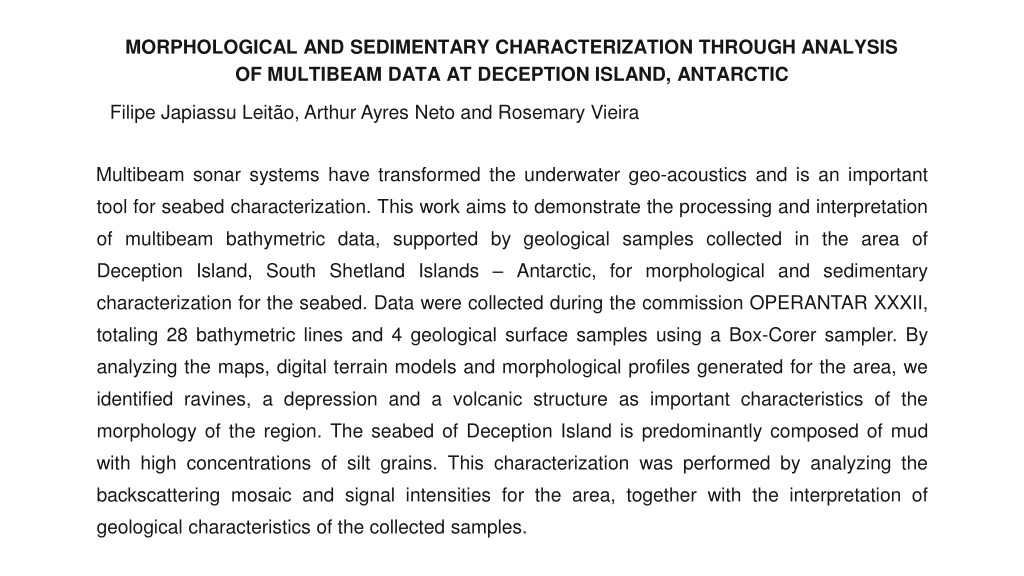Multibeam Data Analysis for Seabed Characterization at Deception Island, Antarctic
This work explores the morphological and sedimentary characterization of the seabed at Deception Island, Antarctic, through the analysis of multibeam bathymetric data and geological samples. The study identifies ravines, depressions, and volcanic structures as key features, revealing a seabed predominantly composed of mud with high silt grain concentrations. The area's significance in providing shelter for ships due to its precise depth determination is highlighted, along with its volcanic history and association with the Bransfield Basin. The analysis sheds light on the region's underwater topography and sediment composition, offering valuable insights for further research and environmental understanding.
Download Presentation

Please find below an Image/Link to download the presentation.
The content on the website is provided AS IS for your information and personal use only. It may not be sold, licensed, or shared on other websites without obtaining consent from the author. Download presentation by click this link. If you encounter any issues during the download, it is possible that the publisher has removed the file from their server.
E N D
Presentation Transcript
MORPHOLOGICAL AND SEDIMENTARY CHARACTERIZATION THROUGH ANALYSIS OF MULTIBEAM DATA AT DECEPTION ISLAND, ANTARCTIC Filipe Japiassu Leit o, Arthur Ayres Neto and Rosemary Vieira Multibeam sonar systems have transformed the underwater geo-acoustics and is an important tool for seabed characterization. This work aims to demonstrate the processing and interpretation of multibeam bathymetric data, supported by geological samples collected in the area of Deception Island, South Shetland Islands Antarctic, for morphological and sedimentary characterization for the seabed. Data were collected during the commission OPERANTAR XXXII, totaling 28 bathymetric lines and 4 geological surface samples using a Box-Corer sampler. By analyzing the maps, digital terrain models and morphological profiles generated for the area, we identified ravines, a depression and a volcanic structure as important characteristics of the morphology of the region. The seabed of Deception Island is predominantly composed of mud with high concentrations of silt grains. This characterization was performed by analyzing the backscattering mosaic and signal intensities for the area, together with the interpretation of geological characteristics of the collected samples.
STUDIED AREA The area under investigation is the Deception Island (Fig. 1) and it is located northwest of the Antarctic Peninsula. The Deception Island is an important structure which composes the South Shetland Islands set and it plays a significant role for the nearby area. Its bay is used as a shelter for the sake of ship safety when there are no conditions of navigation in the region, thus making extremely necessary to determine local depths with precision. According to Martin et al. (2013), the Deception Island is the most active volcano that composes the arc of volcanic islands associated with the rift axis of the Bransfield Strait, being formed during the late Mesozoic-Cenozoic. The Bransfield Basin, a 500 km long and 100 km wide extensional structure, is considered a back-arc basin developed since the Pliocene and associated with subduction of the former Phoenix Plate below the South Shetland Islands (Dalziel, 1984).
RESULTS The final bathymetry generated to the area is of good quality and allowed the analysis of different structures presented on the seabed of Port Foster. As part of the results, Figure 4 represents the map generated to the area. Depth values, represented by the isobaths contours of 5 meters and the scale on the right side of the map, and some seabed features as ravines, a depression and an elevated structure; which represents a volcanic structure, are the main information provided by the map. The first profile, extends since the inlet of Port Foster to one of its extremities and shows that the deepest region within the area of the bay is 170 meters deep. By calculating using the software Google Earth, it was defined that the approximated area is about 36.9 km2. Figure 4 Bathymetric map of Port Foster Bay, using tools of GEOSOFT OASIS MONTAJ.
The bathymetry has indicated the presence of some underwater ravines present in the center of the bay, over its south, east and west flanks, that should be originated either by the influence of thaw water as well as by the strong and historical volcanic activity of the region. Magrani (2011) describes that in glacial environments the ice and thaw water are the main agents of erosion, transportation and deposition of sediments. Moreover, by gravity, glaciers moves down gradient in the direction of the bottom of the bay. Profile 1 (WNW-ESE) along the entrance of Port Foster Bay.
Profile 2 (NW-SE) showing ravines along the eastern flank of Port Foster Bay. Profile 3 (W-E) characterizing a depression close to a inactive volcanic peak at Port Foster
Backscattering signal intensities mosaic. Profile 4 (W-E) detailing the volcanic structure located at the southern flank of Port Foster Bay. Histogram showing the distribution of the backscatter values.
CONCLUSION The Port Foster is an asymmetric bay, with steepest flanks at the west side of the bay. The final bathymetric model for the area allowed the recognition of different morphological features at the seabed of the studied area associated to volcanic and glacial processes. The acoustic characterization carried out after the processing and analysis of the backscattering signal indicated a very sedimentary homogeneity to the area. The geological samples acquired at the area endorse this interpretation, evidencing a seafloor essentially composed by silty sediment. The method could produce a highly detailed acoustic mosaic representing backscatter intensities as well as presented by Innangi et al. (2014). Therefore, the acoustic classification method combining multibeam sonar system with backscatter analysis and geological samples represents nowadays an efficient way to seabed recognition, obtaining information about seafloor s morphological and sedimentary characteristics by a non- invasive tool.
























